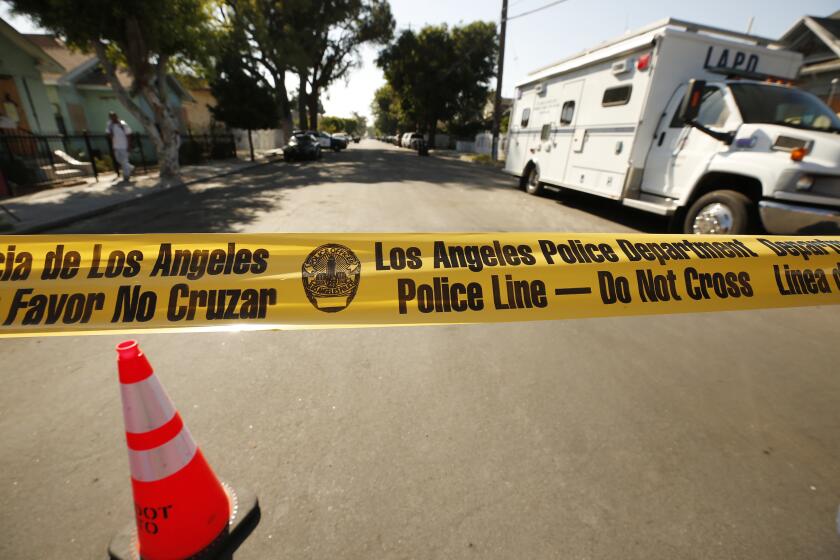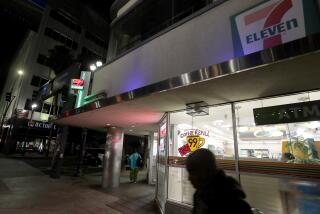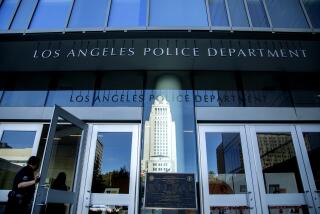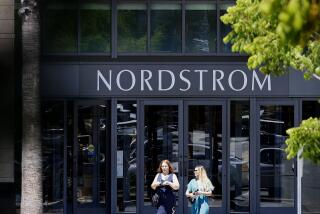LAPD stats showed an uptick in robberies. Was it really just shoplifting?
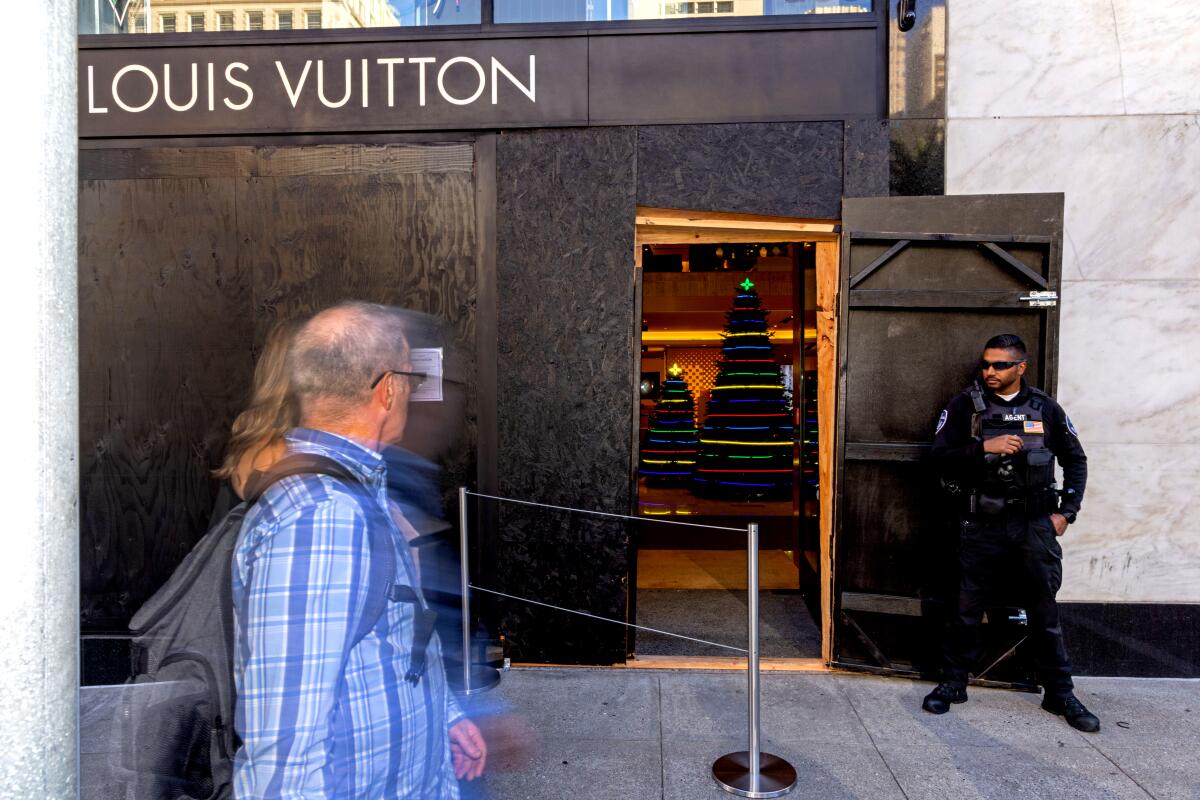
- Share via
- LAPD statistics showed an uptick in robberies in some areas this year, partly caused by shoplifting incidents that led to felony charges.
- Police officials say the increase in so-called “Estes robberies” is the result of some retailers encouraging security guards to aggressively confront thieves.
At the Los Angeles Police Department’s weekly crime briefings this fall, its leaders tracked what seemed to be a troubling rise in robberies in police divisions such as Southwest and Rampart. The numbers showed an increase in stickups — if only on paper.
Upon closer inspection, department records obtained by The Times indicate that most of the incidents may have started as shoplifting.
Under LAPD metrics, hundreds of thefts in which a suspect uses force or fear in the commission of a crime are counted as robberies — even if no weapons were used and no injuries occurred.
It’s a common scenario: A shoplifter, arms full of merchandise they didn’t pay for, makes a beeline for the exit, only to have their escape blocked by a security guard. A struggle ensues, and the thief knocks the guard over or merely threatens to do so, triggering a potential felony charge.
Through the first week of October, there were more than 1,200 such incidents across L.A., according to department statistics released through a public records request. This accounted for roughly 1 in 8 robberies, down slightly compared with the same period in 2023.
An LAPD lieutenant whose officers are accused of trying to cover up illegal traffic stops and thefts by turning off their body-worn cameras has filed a lawsuit claiming he was “set up to fail” and unfairly punished after the scandal became public.
Some officials wonder whether the data reflect a shift by business owners toward more aggressive loss prevention strategies, leading to more in-store confrontations with security guards.
Faced with plunging profit margins, more companies — from mom-and-pop shops to big box retailers such as Target — are making “stopping people at the threshold” a priority, said LAPD Deputy Chief Alan Hamilton, who noted that shoplifting is still a crime, although not the serious type the term “robbery” conjures.
The broad classification, he acknowledged, is potentially muddying the department’s numbers.
“You can do what you want as a business, but you’re not necessarily going to get an accurate crime picture,” said Hamilton, who runs the LAPD’s detective bureau.
Shoplifting incidents that escalate are sometimes referred to as Estes robberies, after a legal standard that dates to the early 1980s, when a man named Curtis Estes tried to walk out of a Sears store in Vallejo wearing a down vest and corduroy coat he hadn’t paid for. When confronted by an armed security guard in the parking lot, Estes pulled a knife out and threatened to kill the guard, before eventually surrendering.
Estes was convicted of felony robbery, which was upheld under appeal with the court ruling that “a store employee may be a victim of a robbery even though he does not own the property taken.”
In the decades since, law enforcement has used the Estes robbery standard to charge shoplifters with robbery even if they didn’t have weapons. Although some incidents can be downgraded by prosecutors to misdemeanors or dismissed due to lack of evidence, the LAPD counts each case it refers as a robbery.
Of the top 10 locations citywide for Estes robberies, the majority occurred at WSS, a Southern California chain formerly known as Warehouse Shoe Sale.
Authorities have said Brian Williams, a top deputy to Mayor Karen Bass, is suspected of sending an anonymous threat about a bomb inside City Hall in October.
The top location was the company’s store at Sunset Boulevard and Western Avenue in Hollywood, which had 22 Estes robberies, followed closely by its location near MacArthur Park, which had 20. Other clusters were reported at a WSS store in the Southwest Division and, separately, downtown’s FIGat7th shopping center.
A WSS representative on Tuesday referred The Times to the company’s corporate office, which didn’t respond to an email seeking comment.
Hamilton, the deputy chief, said the department occasionally meets with businesses to discuss emerging crime trends. Retailers such as WSS, he said, will station guards around their stores to act as a visible deterrent, but also can “harden” themselves against theft by, for instance, keeping only one of every pair of shoes on display.
He added that police typically discourage store employees from physically detaining anyone to avoid turning a nonviolent crime into something more dangerous.
“It absolutely concerns me,” he said. “I’ll take a theft over an Estes any day, because if you have an Estes you always have the potential for catastrophe.”
Stores also can face liability if someone is injured or killed, and the risk of incurring hefty legal costs might not justify trying to wrestle a thief to the ground. There have been numerous instances of confrontations that turned deadly, including a high-profile case in 2023 in San Francisco in which a security guard at a local Walgreens shot and killed an unarmed man he suspected of shoplifting.
LAPD statistics show that assaults on security personnel have risen in the last five years. On Monday night in downtown L.A., a man suspected of stealing shot and wounded two security guards who confronted him outside the Target store at the FIGat7th shopping mall.
The suspect was arrested a day later after an hours-long standoff with police who raided an apartment in the nearby Westlake District.
Some experts said the private security industry is shifting toward nonconfrontational approaches, mostly to avoid injuries to employees and disruptions in service.
Loss prevention specialists and security guards are increasingly being trained to “observe, identify, and document the situation as best as possible and not to necessarily apprehend,” said Geoff Kohl Sr., director of marketing for the Security Industry Assn., a trade group in Maryland.
City and police leaders announced double-digit declines in homicides compared with 2023, including a halving of gang-related slayings, but the recent election results show public safety remains a concern.
Establishments such as jewelry stores that have high-value merchandise may still take forceful measures to prevent losses, but Kohl said the continued growth of the multibillion-dollar private security industry has been driven more by expansion of in-store surveillance.
“You’re gonna see probably less and less weapons being carried and more of a reliance on technology,” he said.
The classification of some minor thefts as Estes robberies raises questions about the reliability of the LAPD’s crime figures, which have come under scrutiny in years past.
Inside the numbers-obsessed department, crime counts still dictate staffing decisions and serve as a benchmark for supervisors, who are still largely judged by their successes and failures in lowering serious crimes — such as homicides, robberies and burglaries — in their divisions.
Released publicly, the LAPD numbers also influence public opinion and become fodder for political debate.
Even though reliable data are scant, the perception that retail theft is out of control statewide helped lead to the passage of Proposition 36 in November, which created stiffer penalties for certain types of thefts and drug crimes.
After a dragged-out political fight in Sacramento over the summer, Gov. Gavin Newsom signed a package of bills to address the rise in organized retail theft, making it easier for police to arrest shoplifters and disrupt larger retail crime rings.
Critics warn that the more punitive approaches could cause more harm than good by rolling back laws aimed at reducing the state’s prison population.
The LAPD has created several task forces to crack down on organized retail theft, and occasionally deploys “blitz operations” that involve sending teams of both undercover and uniformed officers to popular shopping areas.
Jeff Asher, a crime analyst and consultant based in New Orleans, said that outside of homicides and auto theft, most crime categories are notoriously unreliable and prone to underreporting.
Retail theft, in particular, is not well tracked, “which makes it very difficult to say what is an increase and what is an increase in the change in reporting.”
That said, he added, the most reliable data available show that, with few exceptions, shoplifting is lower today than it was before the outbreak of the pandemic.
“Overall in Los Angeles, you’re seeing a decline in both theft and robberies,” he said.
A lawsuit by former SWAT officer Timothy Colomey accused leaders of the LAPD tactical unit of working to conceal unlawful killings and retaliating against him when he spoke to internal investigators.
Beyond potentially distorting the city’s crime numbers, subjecting shoplifters to felony charges has life-altering consequences, according to longtime defense attorney Greg Hill.
Instead of being charged with a misdemeanor or diverted to treatment, a person can suddenly face years in prison if convicted of a felony that is counted as a “strike” — greatly affecting their future job, housing and education opportunities, Hill said.
“Basically, it’s shoplifting with a push,” he said. “And it’s usually because the loss prevention people don’t properly identity themselves and they’re usually not wearing uniforms so it’s not obvious to a shoplifter, so it’s somebody just grabbing their arm.”
More to Read
Sign up for Essential California
The most important California stories and recommendations in your inbox every morning.
You may occasionally receive promotional content from the Los Angeles Times.

